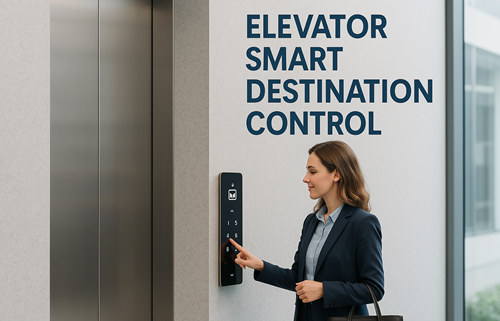“Elevator Destination Control System: An Innovative Solution for Traffic Management”
The Importance of the Issue
With the rise of high-rise and high-traffic buildings, facilitating smooth movement and improving visitor satisfaction have become major challenges for designers and operators. The elevator destination control system, as an intelligent solution, optimizes passenger flow and reduces wait times. This system is particularly effective in buildings with multiple elevators.
Background
Destination control systems emerged as a modern elevator traffic management technology in the 1990s. Early research focused on optimization algorithms and reducing wait times. In recent years, advancements in artificial intelligence (AI), the Internet of Things (IoT), and machine learning have significantly enhanced these algorithms. Today, leading global companies such as Otis, Kone, Schindler, and Mitsubishi provide cutting-edge destination control solutions.
This article examines the challenges of traffic flow management in large complexes and explores destination control systems as an effective and innovative solution. After reviewing the limitations of conventional elevator call systems, we highlight the advantages and applications of destination control, which significantly improves efficiency, reduces wait times, and enhances user satisfaction. The goal is to assist managers and decision-makers in implementing this system in both new and existing buildings.
Challenges of Conventional Elevator Call Systems
-
No destination awareness: Passengers in group elevators cause unnecessary stops.
-
Reverse-direction calls: Elevators may be summoned in the opposite direction of travel.
-
No access control: Inability to restrict floor access.
-
Increased congestion during peak hours: Frequent stops worsen traffic.
-
Excessive stops: Elevators fail to reach optimal speed due to repeated halts.
Advantages and Applications of Destination Control Systems
-
Reduced wait times through optimized traffic flow.
-
Efficient passenger grouping by destination at the lobby.
-
Smart elevator assignment in buildings with non-uniform stops.
-
Enhanced security with access control integration.
-
VIP elevator service for executives and special guests.
-
Priority service to key floors (e.g., conference halls).
-
Automatic access restrictions during peak hours (e.g., parking-to-parking only).
-
Prevention of reverse-direction calls.
-
Energy savings by minimizing unnecessary stops.
Buildings That Benefit Most from Destination Control Systems
Office and Residential Towers
Challenges: Long wait times during peak hours, leading to dissatisfaction among employees and residents.
Benefits:
-
Improved quality of life for residents by reducing elevator crowding.
-
Enhanced security with restricted floor access.
-
VIP elevator service for managers or guests on demand.
-
Increased employee productivity in office buildings.
-
“Guest mode” activation during events to restrict access to specific floors.
Large Hotels and Hospitality Complexes
Challenges: Continuous passenger flow, especially during peak hours, causing congestion.
Benefits:
-
Improved guest experience and brand reputation.
-
Increased security with room key-based access restrictions.
-
Automated limitations to floors with no service during certain hours.
Shopping Malls and Commercial Complexes
Challenges: High customer traffic and uneven distribution between floors, leading to crowding and dissatisfaction.
Benefits:
-
Priority service to high-traffic floors.
-
Automatic inter-floor access restrictions during peak times (e.g., parking-to-parking).
-
Enhanced shopping experience, increasing customer dwell time.
-
Faster inter-floor travel, encouraging more visits.
Hospitals and Medical Centers
Challenges: Poor management of patient, staff, and medical equipment flow, negatively impacting service quality.
Benefits:
-
Efficient patient and equipment movement, improving medical service efficiency.
-
VIP elevator priority for doctors in emergencies via coded floor panels.
-
Restricted access outside visiting hours with pre-defined exit scenarios.
-
Dedicated elevator summoning for stretchers via nursing station panels.
Airports and Large Terminals
Challenges: Poor passenger and luggage traffic management, leading to delays and negative travel experiences.
Benefits:
-
Increased passenger satisfaction and smoother travel.
-
Dynamic capacity adjustments for passengers with luggage.
-
Fewer unnecessary stops, improving service speed.
Conclusion
The elevator destination control system is an effective solution for optimizing traffic and reducing wait times, especially in high-rise, high-traffic buildings. By improving efficiency and passenger flow, it not only boosts productivity but also enhances user experience. Implementing this system in both new and existing complexes can significantly elevate elevator performance, ensuring a seamless and pleasant journey for all.




Leave a Reply
Want to join the discussion?Feel free to contribute!